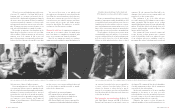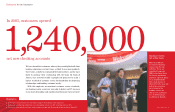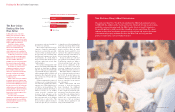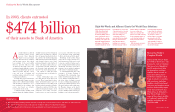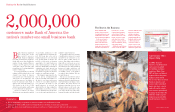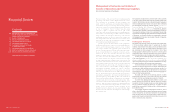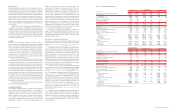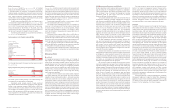Bank of America 2003 Annual Report Download - page 13
Download and view the complete annual report
Please find page 13 of the 2003 Bank of America annual report below. You can navigate through the pages in the report by either clicking on the pages listed below, or by using the keyword search tool below to find specific information within the annual report.
Raising the Bar in Neighborhood Excellence
452,000
In Baltimore’s inner-city Westside,
as in similar communities across
the country, residents and busi-
nesses look to Bank of America’s
leadership, financial services and
development expertise to help their
neighborhoods thrive.
Westside, a historic but neglected
neighborhood, is a prime example of
the depth of the bank’s community
development commitment. For nearly
a decade, the city, the state and
partners like Bank of America have
tackled projects in the 24-block
Westside. Committing $100 million in
loans and investments to the effort,
we are helping to create decent,
affordable housing; reintroduce vital
neighborhood services; stimulate small
business growth; and support cultural
events—boosting community pride and
increasing economic opportunity.
The newly renovated Hippodrome
Performing Arts Center is both corner-
stone and symbol for a $700 million
revitalization that has changed the way
residents view the historic neighbor-
hood. The Hippodrome opened in 1914
as a vaudeville theater, but was trans-
formed in 2003 into a 170,000-square-
foot performing arts complex made
possible by a Bank of America invest-
ment of more than $10 million. We also
provided financing to bridge charitable
contributions. City officials expect the
theater’s 2,250-seat auditorium to host
a wide range of cultural events, help-
ing fuel a Westside renaissance.
Across the street from the
Hippodrome is Centerpoint, with 394
market-rate apartments, prime retail
and restaurant space, parking, a busi-
ness center, a courtyard and exercise
facilities. Bank of America redevel-
oped Centerpoint in a joint venture
with a minority-owned real estate
firm, creating more than 500 new jobs.
In Westside and nearby Harlem
Park, we acted as developer, partner-
ing with a minority-managed, neigh-
borhood-based community develop-
ment corporation to create the first
new housing in the neighborhood in
25 years. We funded a neighborhood
study that identified a need for senior
housing and services for low-income
residents. As a result, the project fea-
tures services requested by residents
and local officials, including medical
facilities and a café.
A $5.5 million loan for the Heritage
Crossing project helped to build 185
single-family homes where blighted
public housing complexes once stood.
Nearby, the restoration of the Orchard
Mews apartment complex provides
more than 100 affordable rental units.
In addition, Bank of America
Foundation grants to Westside and
other Baltimore neighborhoods help
fund social services, cultural programs,
education, health care and job-training
programs, enabling us to fulfill our
pledge to bring higher standards to our
efforts to help build neighborhoods.
Community residents and
opinion leaders expect compa-
nies to demonstrate meaningful,
long-term commitments to their
neighborhoods. Our customers
tell us that they need and value
good corporate leadership
focused on the local issues that
they consider priorities.
In response, the Bank of
America Foundation has created
a new plan for philanthropic
initiatives that address two
critical areas: Neighborhood
Leadership and Social
Leadership.
Neighborhood Leadership
means that much of our philan-
thropy is directed at organiza-
tions providing direct services
that address priority neighbor-
hood issues. Social Leadership
means we use some of our
Foundation grant dollars to sup-
port anchor institutions that are
meeting broader health, educa-
tional and cultural objectives.
Bank of America is commit-
ted to a national strategy that
will feature a signature program
in 32 markets designed to
promote, recognize and reward
people and organizations that
deliver neighborhood excel-
lence, including Neighborhood
Builders, Local Heroes and
Student Leaders. These
programs will be integrated
with our long-standing record
of charitable investments in
underserved neighborhoods,
which is reflected in programs
that provide job development
and training, education and
financial literacy initiatives,
volunteer activities, community
development and neighborhood
revitalization.
BANK OF AMERICA 2003 23
A Partnership with
National Reach
The National Council of
La Raza (NCLR) serves
Hispanics throughout
the country. Our 10-year,
$20 million commitment
to NCLR helps to provide
financing for organizations
such as Academia Semillas
del Pueblo (left). With
affiliates serving 37 states
and the District of
Columbia, NCLR annually
reaches 3.5 million
Hispanics. In 2003, Bank
of America Foundation
granted NCLR $3.6 million
for education, homeowner-
ship and financial growth
for Hispanic families and
small business owners.
affordable new homes
Taking Philanthropy to the Next Level
In 2003, we helped low- and moderate-income
families obtain more than
In 1998, Bank of America made an unprecedented commitment to lend or invest at least $350 billion
in community development over the next ten years. Five years later, in 2003, we had achieved nearly
two-thirds of that goal. We've set a new 10-year goal of $750 billion beginning in 2005.
PROGRESS ON $350 BILLION COMMUNITY DEVELOPMENT COMMITMENT
0$39.6 $69.4 $114.4 $163.3 $232.6 $35
0
1999 2000 2001 2002 2003
■Our work in Baltimore’s Westside is an example of our comprehensive approach to community revitalization.
■Our partnership with the National Council of La Raza benefits 3.5 million Hispanics across the nation.
■We’re well ahead of our 10-year, $350 billion community lending and investing commitment.
Highlights
(DOLLARS IN BILLIONS
AT DECEMBER 31)


